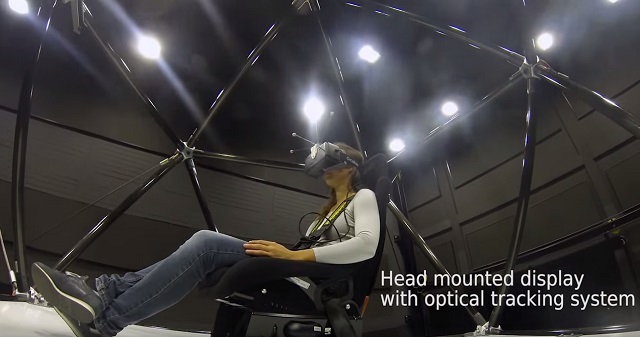The brainchild of Heinrich
Bülthoff’s research group at the Max Planck Institute for Biological Cybernetics and another team from Fraunhofer IPA, the CableRobot Simulator makes complete immersion a reality.
Being composed of a central cockpit frame, a chair, harness, heavily-modified Oculus Rift DK2 and a computer for running the software, the CableRobot Simulator is a motion platform that gives users a full six degrees of freedom for movement. In other words, CableRobot features a much larger degree of movement forward/backward and left/right, than its fixed-base counterparts. The platform is attached with several heavy-duty strings to the corners of the room, and depending on which of the strings are tensioned, the frame moves in one direction or another.

“We’re currently using a DK2 as the initial visualization solution but might also use projection or other large-screen solutions in the future.
Better HMDs of course as well,” explained Joachim Tesch, a developer on the project. “Since the Oculus DK2 tracking system was not designed to work on a motion simulator we are using an external optical tracking system. This is still work-in-progress and needs further improvement to match the quality of the Oculus tracking solution.”
The two teams of researchers have developed simulators that work specifically with this motion platform: “Graphics for flight and driving visuals are done in Unreal Engine 4. We modified it to work with the optical tracking system and also to connect it to our simulation environment.” Speaking of the optical tracking system, CableRobot makes use of a proprietary one that detects the position of a user’s head using an HMD mounted three-point system.
I wonder how the developers of this project are going to handle virtual reality sickness, as there’s much more motion involved in the CableRobot than in other similar platforms. Should their motion platform go mainstream (preferably in amusement parks, rather than at individuals’ homes), I really think that people should give this contraption a “test drive” before investing in it. Regardless of its destination, the developers of the motion platform should test its safety properly before launching a commercial version, as dying while using such a machine is not entirely impossible. It remains to be seen what the future holds for us in terms of virtual reality simulators, but now that Valve has announced that Half Life 3 won’t be made for VR, I guess that people aren’t that anxious to try these, anymore.
Check out the following video to get a better idea of how the CableRobot simulator looks and works in real life.
Be social! Follow Walyou on Facebook and Twitter, and read more related stories about the Vertigo simulator, the closest thing to virtual reality yet, or the Kat Walk VR treadmill that makes games more immersive.
Via: Road to VR










